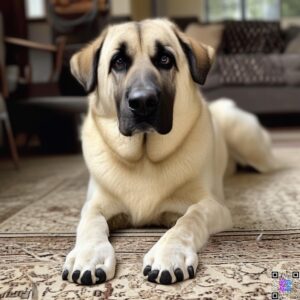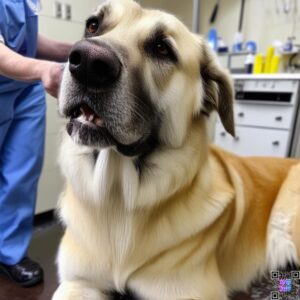Introduction
The Anatolian Shepherd is a majestic breed with a rich history, originating from the Anatolian region of Turkey. These loyal and hardworking dogs have been used for centuries to guard livestock and protect their families. With their muscular build, thick coats, and striking facial features, Anatolian Shepherds are instantly recognizable. However, some members of this breed possess an additional characteristic that sets them apart: an extra toe, known as polydactyly.
Anatolian Shepherd Extra Toe

An extra toe, or polydactyly, is a genetic condition that can occur in Anatolian Shepherds. This condition is characterized by the presence of an additional digit on one or more of the dog’s paws. While it may seem unusual, extra toes are not uncommon in this breed.
Understanding the Anatolian Shepherd
The Anatolian Shepherd is not just any dog; it’s a guardian breed with deep historical roots. Originating from Turkey, these dogs were bred to protect livestock from predators. Their impressive size and strength make them formidable guardians. Typically weighing between 110 to 150 pounds and standing 27 to 32 inches tall at the shoulder, they are built for endurance and resilience.Their temperament is another defining feature. Known for being independent yet loyal, Anatolian Shepherds require experienced handlers who can provide firm training. They thrive in environments where they can exercise their natural instincts while being part of a family or a flock.
What is the Extra Toe?
Dewclaws are often overlooked but play a crucial role in a dog’s anatomy. These are small, vestigial toes located higher up on the leg than the other four toes. In some breeds, including the Anatolian Shepherd, these extra toes can be more pronounced.The extra toe serves several purposes: it helps with grip when climbing or navigating rough terrain and provides stability during fast movements. In the case of the Anatolian Shepherd, having an extra toe can enhance their ability to perform their guardian duties effectively.
Genetics Behind the Extra Toe
Polydactyly refers to the condition where an animal has more than the usual number of digits on its paws. In dogs, this condition manifests as extra dewclaws. For Anatolian Shepherds, having an extra toe is not uncommon and can be traced back through their genetic lineage.Genetic testing can confirm whether a dog carries this trait. Understanding these genetic factors is essential for breeders and owners alike to ensure healthy breeding practices and maintain breed standards.
Causes of Extra Toes
The presence of an extra toe in Anatolian Shepherds is caused by a genetic mutation that affects the development of the paws. This mutation can be inherited from one or both parents, depending on the specific genetic makeup of the individual dog.
Prevalence of Extra Toes
The prevalence of extra toes in Anatolian Shepherds varies, but it is estimated that around 10-15% of the breed may exhibit this trait. While it is more common in some bloodlines, extra toes can occur in any Anatolian Shepherd.
Genetic Basis of Extra Toes
The genetic basis of extra toes in Anatolian Shepherds is complex and not fully understood. However, researchers believe that the condition is caused by a dominant genetic mutation that affects the development of the paws.
Polydactyly in Anatolian Shepherds
Polydactyly is the scientific term used to describe the presence of extra digits in animals. In Anatolian Shepherds, polydactyly typically affects the front paws, with the extra toe appearing on the inside of the leg.
Inheritance Patterns
The inheritance pattern of extra toes in Anatolian Shepherds is not straightforward. If one parent carries the mutation, there is a 50% chance that each offspring will inherit the extra toe. If both parents carry the mutation, the likelihood of an extra toe increases to 75%.
Genetic Testing
Genetic testing is available to determine if an Anatolian Shepherd carries the mutation for extra toes. This information can be useful for breeders who want to make informed decisions about breeding and avoid producing puppies with this trait.
Impact of Extra Toes
The presence of an extra toe in an Anatolian Shepherd can have various impacts on the dog’s health, appearance, and breeding considerations.
Health Implications
In most cases, an extra toe does not cause any health problems for the dog. However, in some instances, the extra digit may be prone to injury or infection, requiring veterinary attention.
Appearance and Conformation
The presence of an extra toe can affect the overall appearance and conformation of an Anatolian Shepherd. While it is not considered a disqualifying fault in the breed standard, some judges may view it as a cosmetic flaw.
Breeding Considerations
When it comes to breeding Anatolian Shepherds, the presence of an extra toe is an important consideration. Breeders may choose to avoid breeding dogs with this trait to prevent producing puppies with extra toes. However, it is important to note that the breed standard does not prohibit dogs with extra toes from being bred.
Management and Care
Managing and caring for an Anatolian Shepherd with an extra toe is similar to caring for any other member of the breed. However, there are some specific considerations to keep in mind.
Identifying Extra Toes
Extra toes in Anatolian Shepherd puppies can be identified at birth. Breeders and owners should carefully examine each puppy’s paws to ensure that any extra digits are properly cared for.
Veterinary Care
If an extra toe is causing discomfort or health issues for the dog, veterinary care may be necessary. A veterinarian can assess the condition and recommend appropriate treatment options, such as trimming the extra nail or surgically removing the extra digit.
Grooming and Maintenance
Grooming and maintaining an Anatolian Shepherd with an extra toe is similar to caring for any other member of the breed. Regular brushing, bathing, and nail trimming are essential for keeping the dog’s coat and paws healthy.

Frequently Asked Questions
1- Is an extra toe in an Anatolian Shepherd harmful?
In most cases, an extra toe does not cause any harm to the dog. However, in some instances, the extra digit may be prone to injury or infection, requiring veterinary attention.
2- Can an Anatolian Shepherd with extra toes be shown?
While the presence of an extra toe is not considered a disqualifying fault in the breed standard, some judges may view it as a cosmetic flaw. It is up to the individual judge to determine if the dog meets the overall breed standard.
3- How common are extra toes in Anatolian Shepherds?
It is estimated that around 10-15% of Anatolian Shepherds may exhibit the presence of an extra toe. While it is more common in some bloodlines, extra toes can occur in any member of the breed.
4- Can extra toes be prevented in Anatolian Shepherd breeding?
Breeders can choose to avoid breeding dogs with extra toes to prevent producing puppies with this trait. However, it is important to note that the breed standard does not prohibit dogs with extra toes from being bred.
5- What should I do if my Anatolian Shepherd has an extra toe?
If an extra toe is causing discomfort or health issues for the dog, it is recommended to consult with a veterinarian. A veterinarian can assess the condition and recommend appropriate treatment options, such as trimming the extra nail or surgically removing the extra digit.
6- Are there any health benefits to an extra toe in Anatolian Shepherds?
There are no known health benefits to an extra toe in Anatolian Shepherds. The presence of an extra digit is a genetic trait that does not provide any functional advantages for the dog.
Conclusion
The Anatolian Shepherd is a unique and fascinating breed, known for its majestic appearance and occasional presence of an extra toe. While this trait is not harmful in most cases, it is important for owners and breeders to understand the genetic basis and potential implications of extra toes. By working closely with veterinarians and making informed decisions about breeding, Anatolian Shepherd enthusiasts can ensure the health and well-being of these remarkable dogs.
